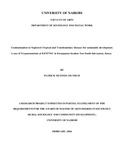| dc.description.abstract | Post-2015 development agenda notably sustainable development goals (SDGs) call for global action by
the international community and the national government to promote shared prosperity and well-being
for all, over the next 15 years. Communication on neglected tropical and transboundary diseases
specifically- African trypanosomiasis- could impede attaining of SDGs numbers 3(good health and wellbeing),
2(Zero hunger) and 1(No poverty) in that order. Through effective communication, the constant
awareness within the states and transboundary areas may improve the situation.
A descriptive method of study was used to assess the effectiveness of communication in control and
eradication of trypanosomiasis as a neglected tropical and transboundary disease. Household survey of
211 participants triangulated by nine key informants, two focus group discussion and observation
techniques were used in gathering the data for assessing the effectiveness of communication on
trypanosomiasis by KENTTEC programs at Kwang’amor location Teso South sub-county Kenya. The
quantitative and qualitative data collected was analyzed using Stata/IC version 12.
Dialogic (two-way communication) model representing 68.2% was used by a majority of researchers in
communication on control and eradication of tsetse and trypanosomiasis with an efficient use of 31.8%
of a monologic (one-way communication) model. Community participation in communication on
control and eradication of trypanosomiasis represented 54.5% while 45.5% had not participated in
communication about trypanosomiasis control. Functional participation represented the majority at
35.3% and only 8.9% were at participation empowerment level.
The interplay of internal and external factors influenced community member’s communication on
control and eradication of tsetse and trypanosomiasis. A greater number that is 99.5% of the participants
were aware that trypanosomiasis is transmitted by tsetse bite to both human and livestock (cows). As a
result, 40.5% agreed that the existing channels of communication were effective. On the outcome, the
majority of respondents 38% strongly agreed that the information acquired from the control of tsetse had
led to improved food production, reduced cases of sleeping sickness, reduced cases of Nagana, increased
employment opportunities, more income saving and more money for the education of their children.
In conclusion, persistent use of two-way communication with effective use of one-way communication,
biased on a use of internal factors and effective use of external factors in community communication on
tsetse and trypanosomiasis control and eradication, improves the effectiveness of development
communication; hence sustainable development | en_US |



